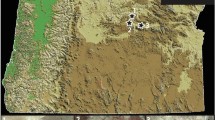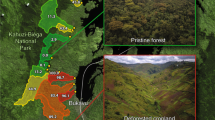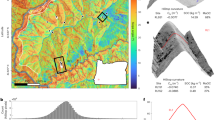Abstract
The long-term effects of deforestation on tropical forest soil carbon reservoirs are important for estimating the consequences of land use on the global carbon cycle, but are poorly understood. The Maya Lowlands of Mexico and Guatemala provide a unique opportunity to assess this question, given the widespread deforestation by the ancient Maya that began ~4,000 years ago. Here, we compare radiocarbon ages of plant waxes and macrofossils in sediment cores from three lakes in the Maya Lowlands to record past changes in the mean soil transit time of plant waxes (MTTwax). MTTwax indicates the average age of plant waxes that are transported from soils to lake sediments, and comparison of radiocarbon data from soils and lake sediments within the same catchment indicates that MTTwax reflects the age of carbon in deep soils. All three sediment cores showed a decrease in MTTwax, ranging from 2,300 to 800 years, over the past 3,500 years. This decrease in MTTwax, indicating shorter storage times for carbon in lake catchment soils, is associated with evidence for ancient Maya deforestation. MTTwax never recovered to pre-deforestation values, despite subsequent reforestation, implying that current tropical deforestation will have long-lasting effects on soil carbon sinks.
This is a preview of subscription content, access via your institution
Access options
Access Nature and 54 other Nature Portfolio journals
Get Nature+, our best-value online-access subscription
$29.99 / 30 days
cancel any time
Subscribe to this journal
Receive 12 print issues and online access
$259.00 per year
only $21.58 per issue
Buy this article
- Purchase on Springer Link
- Instant access to full article PDF
Prices may be subject to local taxes which are calculated during checkout




Similar content being viewed by others
References
Hiederer, R. & Köchy, M. Global Soil Organic Carbon Estimates and the Harmonized World Soil Database (Publications Office of the European Union, 2011).
Scharlemann, J. P., Tanner, E. V., Hiederer, R. & Kapos, V. Global soil carbon: understanding and managing the largest terrestrial carbon pool. Carbon Manage. 5, 81–91 (2014).
Moore, S. et al. Deep instability of deforested tropical peatlands revealed by fluvial organic carbon fluxes. Nature 493, 660–663 (2013).
Conant, R. T. et al. Temperature and soil organic matter decomposition rates–synthesis of current knowledge and a way forward. Glob. Change Biol. 17, 3392–3404 (2011).
Jobbagy, E. G. & Jackson, R. B. The vertical distribution of soil organic carbon and its relation to climate and vegetation. Ecol. Appl. 10, 423–436 (2000).
Torn, M. S., Trumbore, S. E., Chadwick, O. A., Vitousek, P. M. & Hendricks, D. M. Mineral control of soil organic carbon storage and turnover. Nature 389, 170–173 (1997).
He, Y. et al. Radiocarbon constraints imply reduced carbon uptake by soils during the 21st century. Science 353, 1419–1424 (2016).
Trumbore, S. Age of soil organic matter and soil respiration: radiocarbon constraints on belowground C dynamics. Ecol. Appl. 10, 399–411 (2000).
Don, A., Schumacher, J. & Freibauer, A. Impact of tropical land-use change on soil organic carbon stocks: a meta-analysis. Glob. Change Biol. 17, 1658–1670 (2011).
Schmidt, M. W. I. et al. Persistence of soil organic matter as an ecosystem property. Nature 478, 49–56 (2011).
Turner, B. L. II in Precolumbian Population History in the Maya Lowlands (eds Culbert, T. P. & Rice, D. S.) 301–324 (Univ. New Mexico Press, Albuquerque, 1990).
Anselmetti, F. S., Hodell, D. A., Ariztegui, D., Brenner, M. & Rosenmeier, M. F. Quantification of soil erosion rates related to ancient Maya deforestation. Geology 35, 915–918 (2007).
Wahl, D., Byrne, R., Schreiner, T. & Hansen, R. Palaeolimnological evidence of late-Holocene settlement and abandonment in the Mirador Basin, Peten, Guatemala. Holocene 17, 813–820 (2007).
Beach, T. et al. Stability and instability on Maya Lowlands tropical hillslope soils. Geomorphology 305, 185–208 (2018).
Leyden, B. W. Man and climate in the Maya Lowlands. Quat. Res 28, 407–417 (1987).
Mueller, A. D. et al. Recovery of the forest ecosystem in the tropical lowlands of northern Guatemala after disintegration of Classic Maya polities. Geology 38, 523–526 (2010).
Leyden, B. W., Brenner, M. & Dahlin, B. H. Cultural and climatic history of Coba, a lowland Maya city in Quintana Roo, Mexico. Quat. Res. 49, 111–122 (1998).
Kolattukudy, P. Plant waxes. Lipids 5, 259–275 (1970).
Douglas, P. M. et al. Drought, agricultural adaptation, and sociopolitical collapse in the Maya Lowlands. Proc. Natl Acad. Sci. USA 112, 5607–5612 (2015).
Douglas, P. M. et al. Pre-aged plant waxes in tropical lake sediments and their influence on the chronology of molecular paleoclimate proxy records. Geochim Cosmochim. Acta 141, 346–364 (2014).
Bush, R. T. & McInerney, F. A.. Leaf wax n-alkane distributions in and across modern plants: implications for paleoecology and chemotaxonomy. Geochim. Cosmochim. Acta 117, 161–179 (2013).
Sierra, C. A., Müller, M., Metzler, H., Manzoni, S. & Trumbore, S. E. The muddle of ages, turnover, transit, and residence times in the carbon cycle. Glob. Change Biol. 23, 1763–1773 (2017).
Tao, S., Eglinton, T. I., Montlu‡on, D. B., McIntyre, C. & Zhao, M. Pre-aged soil organic carbon as a major component of the Yellow River suspended load: regional significance and global relevance. Earth Planet. Sci. Lett. 414, 77–86 (2015).
Feng, X. et al. Differential mobilization of terrestrial carbon pools in Eurasian Arctic river basins. Proc. Natl Acad. Sci. USA 110, 14168–14173 (2013).
Vonk, J. E., van Dongen, B. E. & Gustafsson, O. Selective preservation of old organic carbon fluvially released from sub-Arctic soils. Geophys Res. Lett. 37, L11605 (2010).
Voort, T. et al. Diverse soil carbon dynamics expressed at the molecular level. Geophys. Res. Lett. 44, 11840–11850 (2017).
Gierga, M. et al. Long-stored soil carbon released by prehistoric land use: evidence from compound-specific radiocarbon analysis on Soppensee lake sediments. Quat. Sci. Rev. 144, 123–131 (2016).
Schefuß, E. et al. Hydrologic control of carbon cycling and aged carbon discharge in the Congo River basin. Nat. Geosci. 9, 687–690 (2016).
Smittenberg, R. H., Eglinton, T. I., Schouten, S. & Damste, J. S. S. Ongoing buildup of refractory organic carbon in boreal soils during the Holocene. Science 314, 1283–1286 (2006).
Rumpel, C. & Kögel-Knabner, I. Deep soil organic matter—a key but poorly understood component of terrestrial C cycle. Plant Soil 338, 143–158 (2011).
Lechleitner, F. A., Dittmar, T., Baldini, J. U., Prufer, K. M. & Eglinton, T. I. Molecular signatures of dissolved organic matter in a tropical karst system. Org. Geochem. 113, 141–149 (2017).
Drenzek, N. J., Montlucon, D. B., Yunker, M. B., Macdonald, R. W. & Eglinton, T. I. Constraints on the origin of sedimentary organic carbon in the Beaufort Sea from coupled molecular C-13 and C-14 measurements. Mar. Chem. 103, 146–162 (2007).
Rice, D.. & Rice, P. in Precolumbian Population History in the Maya Lowlands (eds Culbert, T. P. & Rice, D. S.) 123–148 (Univ. New Mexico Press, Albuquerque, 1990).
Dunning, N. P. & Beach, T. in Landscapes and Societies: Selected Cases (eds Martini, I. P. & Chesworth, W.) 369–389 (Springer, Dordrecht, 2011).
Schwartz, N. in The Social Causes of Deforestation in Latin America (eds Schwartz, N., Painter, M. & Durham, W. H.) 101–130 (Univ. Michigan Press, Ann Arbor, 1995).
Douglas, P. M., Demarest, A. A., Brenner, M. & Canuto, M. A. Impacts of climate change on the collapse of Lowland Maya civilization. Annu. Rev. Earth Planet. Sci. 44, 613–645 (2016).
Rowley, M. C., Grand, S. & Verrecchia, É. P. Calcium-mediated stabilisation of soil organic carbon. Biogeochemistry 137, 27–49 (2018).
Bautista, F., Palacio-Aponte, G., Quintana, P. & Zinck, J. A. Spatial distribution and development of soils in tropical karst areas from the Peninsula of Yucatan, Mexico. Geomorphology 135, 308–321 (2011).
Xiao, S., Zhang, W., Ye, Y., Zhao, J. & Wang, K. Soil aggregate mediates the impacts of land uses on organic carbon, total nitrogen, and microbial activity in a Karst ecosystem. Sci. Rep. 7, 41402 (2017).
Six, J., Conant, R., Paul, E. A. & Paustian, K. Stabilization mechanisms of soil organic matter: implications for C-saturation of soils. Plant Soil 241, 155–176 (2002).
Jiang, Y.-J. et al. Impact of land-use change on soil properties in a typical karst agricultural region of Southwest China: a case study of Xiaojiang watershed, Yunnan. Environ. Geol. 50, 911 (2006).
Hu, Y., Du, Z., Wang, Q. & Li, G. Combined deep sampling and mass-based approaches to assess soil carbon and nitrogen losses due to land-use changes in karst area of southwestern China. Solid Earth 7, 1075–1084 (2016).
Hodell, D. A., Brenner, M. & Curtis, J. H. Terminal classic drought in the northern Maya lowlands inferred from multiple sediment cores in Lake Chichancanab (Mexico). Quat. Sci. Rev. 24, 1413–1427 (2005).
Berhe, A. A. & Kleber, M. Erosion, deposition, and the persistence of soil organic matter: mechanistic considerations and problems with terminology. Earth Surf. Proc. Land 38, 908–912 (2013).
Kaplan, J. O. et al. Holocene carbon emissions as a result of anthropogenic land cover change. Holocene 21, 775–791 (2011).
Bauska, T. K. et al. Links between atmospheric carbon dioxide, the land carbon reservoir and climate over the past millennium. Nat. Geosci. 8, 383–387 (2015).
Ruddiman, W. F. The anthropogenic greenhouse era began thousands of years ago. Clim. Change 61, 261–293 (2003).
Bauer-Gottwein, P. et al. Review: the Yucatán Peninsula karst aquifer, Mexico. Hydrogeol. J. 19, 507–524 (2011).
Johnston, K. J. Preclassic Maya occupation of the Itzan escarpment, lower Río de la Pasión, Petén, Guatemala. Anc. Mesoam. 17, 177–201 (2006).
Leyden, B. W. Pollen evidence for climatic variability and cultural disturbance in the Maya lowlands. Anc. Mesoam. 13, 85–101 (2002).
New, M., Lister, D., Hulme, M. & Makin, I. A high-resolution data set of surface climate over global land areas. Clim. Res. 21, 1–25 (2002).
Olson, D. M. et al. Terrestrial ecoregions of the world: a new global map of terrestrial ecoregions provides an innovative tool for conserving biodiversity. BioScience 51, 933–938 (2001).
Nachtergaele, F. et al. Harmonized World Soil Database Version 1 3–43 (FAO, IIASA, ISRIC & ISS-CAS, 2009).
Rosenmeier, M. F., Hodell, D. A., Brenner, M., Curtis, J. H. & Guilderson, T. P. A 4000-year lacustrine record of environmental change in the southern Maya lowlands, Peten, Guatemala. Quat. Res. 57, 183–190 (2002).
Rosenmeier, M. F. et al. Influence of vegetation change on watershed hydrology: implications for paleoclimatic interpretation of lacustrine δ18O records. J. Paleolimnol. 27, 117–131 (2002).
Eglinton, T. I., Aluwihare, L. I., Bauer, J. E., Druffel, E. R. M. & McNichol, A. P. Gas chromatographic isolation of individual compounds from complex matrices for radiocarbon dating. Anal. Chem. 68, 904–912 (1996).
Galy, V. & Eglinton, T. Protracted storage of biospheric carbon in the Ganges–Brahmaputra basin. Nat. Geosci. 4, 843–847 (2011).
Douglas, P. M. J., Pagani, M., Brenner, M., Hodell, D. A. & Curtis, J. H. Aridity and vegetation composition are important determinants of leaf-wax δD values in southeastern Mexico and Central America. Geochim. Cosmochim. Acta 97, 24–45 (2012).
Liu, H. & Liu, W. Concentration and distributions of fatty acids in algae, submerged plants and terrestrial plants from the northeastern Tibetan Plateau. Org. Geochem. 113, 17–26 (2017).
Wu, M. S. et al. Altitude effect on leaf wax carbon isotopic composition in humid tropical forests. Geochim. Cosmochim. Acta 206, 1–17 (2017).
Hodell, D. A., Curtis, J. H. & Brenner, M. Possible role of climate in the collapse of Classic Maya civilization. Nature 375, 391–394 (1995).
Hodell, D. A., Brenner, M., Curtis, J. H. & Guilderson, T. Solar forcing of drought frequency in the Maya lowlands. Science 292, 1367–1370 (2001).
Brock, F., Higham, T., Ditchfield, P. & Ramsey, C. B. Current pretreatment methods for AMS radiocarbon dating at the Oxford Radiocarbon Accelerator Unit (ORAU). Radiocarbon 52, 103–112 (2010).
Midwood, A. & Boutton, T. Soil carbonate decomposition by acid has little effect on δ13C of organic matter. Soil Biol. Biochem. 30, 1301–1307 (1998).
Blaauw, M. Methods and code for ‘classical’ age-modelling of radiocarbon sequences. Quat. Geochronol. 5, 512–518 (2010).
Reimer, P. J. et al. IntCal13 and Marine13 radiocarbon age calibration curves 0–50,000 years cal BP. Radiocarbon 55, 1869–1887 (2013).
Häggi, C., Zech, R., McIntyre, C. & Eglinton, T. On the stratigraphic integrity of leaf-wax biomarkers in loess-paleosols. Biogeosciences 11, 2455–2463 (2014).
Hikosaka, K. Leaf canopy as a dynamic system: ecophysiology and optimality in leaf turnover. Ann. Bot. 95, 521–533 (2004).
Cornett, R., Risto, B. & Lee, D. Measuring groundwater transport through lake sediments by advection and diffusion. Water Resour. Res. 25, 1815–1823 (1989).
Binford, M. W. Calculation and uncertainty analysis of 210Pb dates for PIRLA project lake sediment cores. J. Paleolimnol. 3, 253–267 (1990).
Deevey, E. S. Jr, Brenner, M. & Binford, M. W. Paleolimnology of the Peten Lake District, Guatemala III: Late Pleistocene and Gamblian environments of the Maya area. Hydrobiologia 103, 211–216 (1983).
Acknowledgements
This paper is dedicated to M. Pagani. We thank A. McNichol and L. Xu for facilitating many of the compound-specific radiocarbon measurements. Funding for this work was provided, in part, by a US National Science Foundation Graduate Research Fellowship (to P.M.J.D.) and by a grant from the Italian Ministry of the Environment (to M.P.).
Author information
Authors and Affiliations
Contributions
P.M.J.D. and M.P. designed the study. M.B., J.H.C., A.B. and K.J. collected, described and sampled the sediment cores. M.P. collected the soil samples. P.M.J.D. performed the geochemical analyses, under the guidance of T.I.E. and M.P. P.M.J.D. analysed the data and wrote the manuscript, with input from all authors.
Corresponding author
Ethics declarations
Competing interests
The authors declare no competing interests.
Additional information
Publisher’s note: Springer Nature remains neutral with regard to jurisdictional claims in published maps and institutional affiliations.
Supplementary information
Rights and permissions
About this article
Cite this article
Douglas, P.M.J., Pagani, M., Eglinton, T.I. et al. A long-term decrease in the persistence of soil carbon caused by ancient Maya land use. Nature Geosci 11, 645–649 (2018). https://doi.org/10.1038/s41561-018-0192-7
Received:
Accepted:
Published:
Issue Date:
DOI: https://doi.org/10.1038/s41561-018-0192-7
This article is cited by
-
Rhizospheric soil organic carbon accumulated but its molecular groups redistributed via rhizospheric soil microorganisms along multi-root Cerasus humilis plantation chronosequence at the karst rocky desertification control area
Environmental Science and Pollution Research (2023)
-
Paleolimnology in support of archeology: a review of past investigations and a proposed framework for future study design
Journal of Paleolimnology (2021)
-
Deforestation and reforestation impacts on soils in the tropics
Nature Reviews Earth & Environment (2020)
-
Soil carbon unearthed
Nature Geoscience (2020)
-
Asian dust-storm activity dominated by Chinese dynasty changes since 2000 BP
Nature Communications (2020)



